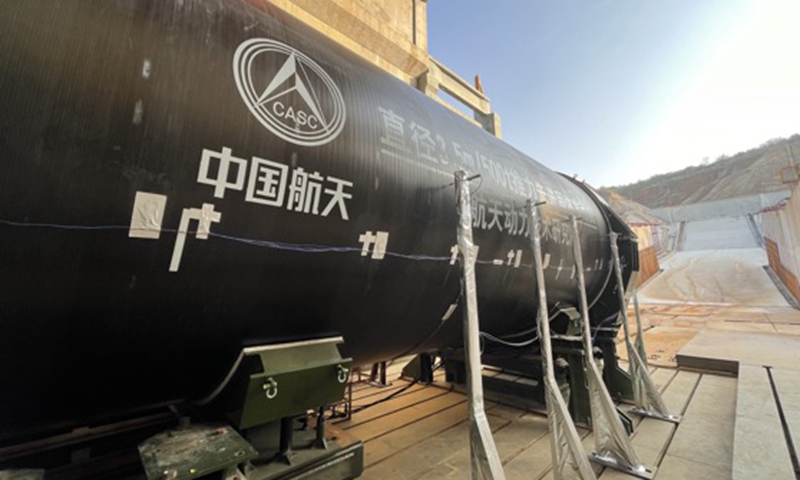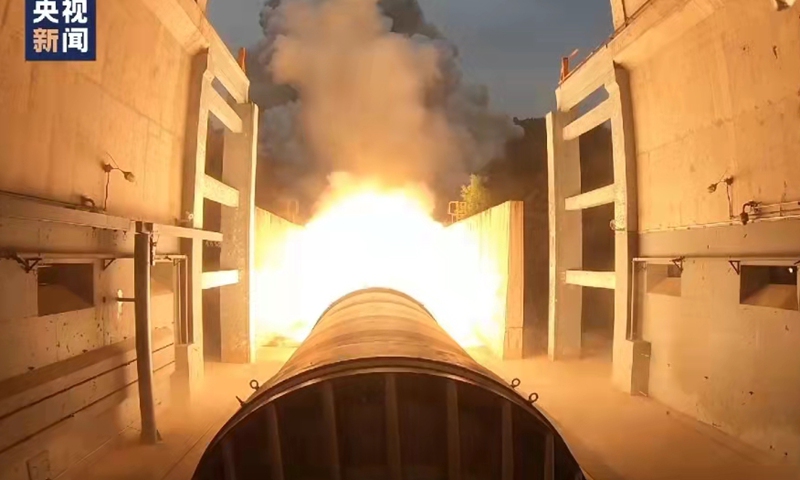To meet demand for manned moon landings, deep space missions: developers
Closely following the heart-stopping and spectacular launch of the Shenzhou-13 manned spacecraft on Saturday, China has made another breakthrough in its aerospace technology, as researchers at the Academy of Aerospace Solid Propulsion Technology (AASPT) announced on Tuesday they conducted a successful running test of a domestically developed solid rocket engine, with a thrust of more than 500 tons, in Xi’an, capital of Northwest China’s Shaanxi Province, setting a world record in the field,
The Global Times learned from the AASPT, which is affiliated with state-owned aerospace giant China Aerospace Science and Technology Corp (CASC), that the 3.5-meter-diameter solid engine’s charge quantity reached 150 tons.
The successful test signals significant progress in China’s solid carrier rocket technology and lays the foundation for the development of large-scale, heavy-lift launch vehicle technology.
The development of the 500-ton thrust solid engine has entered the engineering application stage, while the landmark test opened up a key technology link for the development of China’s 1,000-ton solid thrust engine, the academy said in a statement sent to the Global Times.

Photo: courtesy of CASC
The research and development of rocket engine technology has led the development of launch vehicles, with several steps along the way.
In 2009, China developed a 2-meter-diameter, 120-ton-thrust solid engine, a record at that time, which directly pushed forward the development of the country’s first solid carrier rocket, the Long March-11.
In 2016, by successfully linking 120-ton thrust engines, the country’s first bundled solid booster launch vehicle – the Long March-6A – won state approval for development.
In 2019, the roll-out of a 2.6-meter-diameter, 200-ton-thrust solid engine drove the project approval of the development of the Smart Dragon-3 (SD-3) commercial carrier rocket.
As the latest member of the CALT Smart Dragon commercial rocket family, the SD-3 gained project approval on December 31, 2020, and China will launch the new make through a seaborne platform in the first half of 2022, Jiang Jie, a CALT rocket expert, told the Global Times.
According to CALT, the 2.64-meter-diameter SD-3 with a 3.35-meter-diameter nose cone is the largest and strongest in the Smart Dragon rocket series. It is capable of sending a payload of 1.5 tons into 500-kilometer sun-synchronous orbit.
Jiang, who is also an academician of the Chinese Academy of Sciences, revealed that the SD-3 aims to meet the market need for launches of large-scale commercial satellite constellations, as it is capable of sending as many as 20 satellites in one go.
The SD-3 would reduce the unit cost of payloads to $10,000 per kilogram, said CALT, highlighting the model’s strong market competitiveness.
Researchers with the academy told the Global Times on Tuesday that they believe the new 500-ton thrust engine offers more options for large and heavy-lift carrier rockets.
Observers said that the running test of the powerful solid engine set a new high in the field, lifting China’s large-scale solid rocket engine technology to world-leading levels, and will provide China’s new solid carrier rockets with more powerful and cost-effective advanced power. It will also significantly enhance the competitiveness of solid rockets in the commercial space launch market.
Based on the single 500-ton-thrust solid engine, the academy has set out to research a 3.5-meter-diameter five-stage engine, which would provide a total thrust of more than 1,000 tons, which is expected to be applied in the boosters of large and heavy-lift engines.
Such new technology would meet the demand of China’s space program such as manned moon landings and deep space exploration, the academy revealed.



